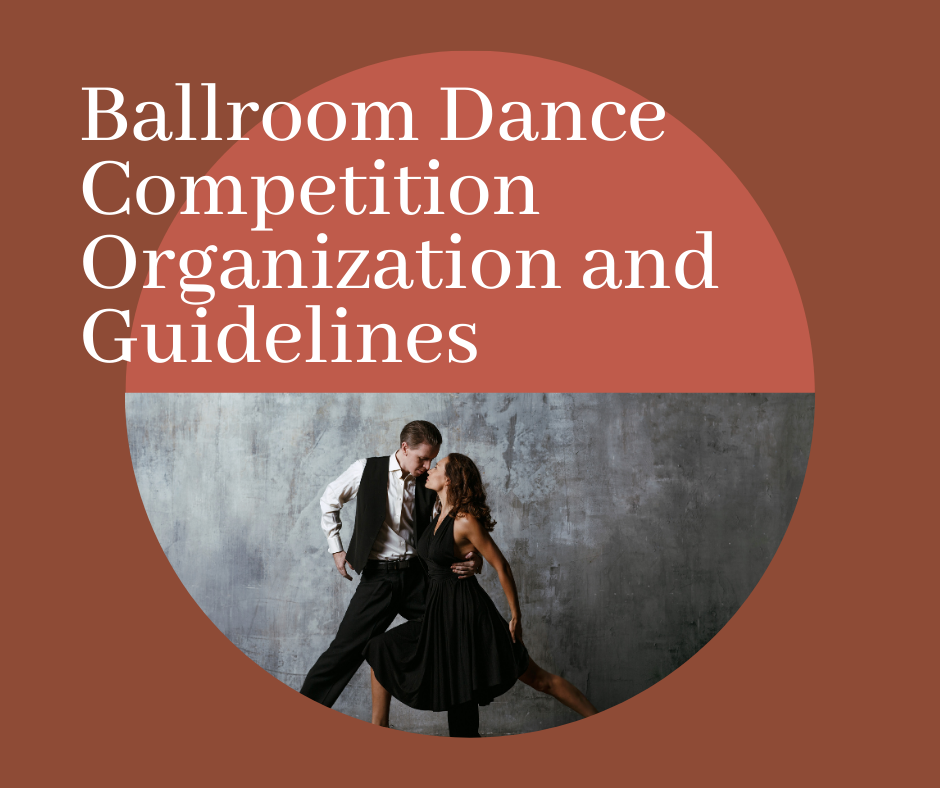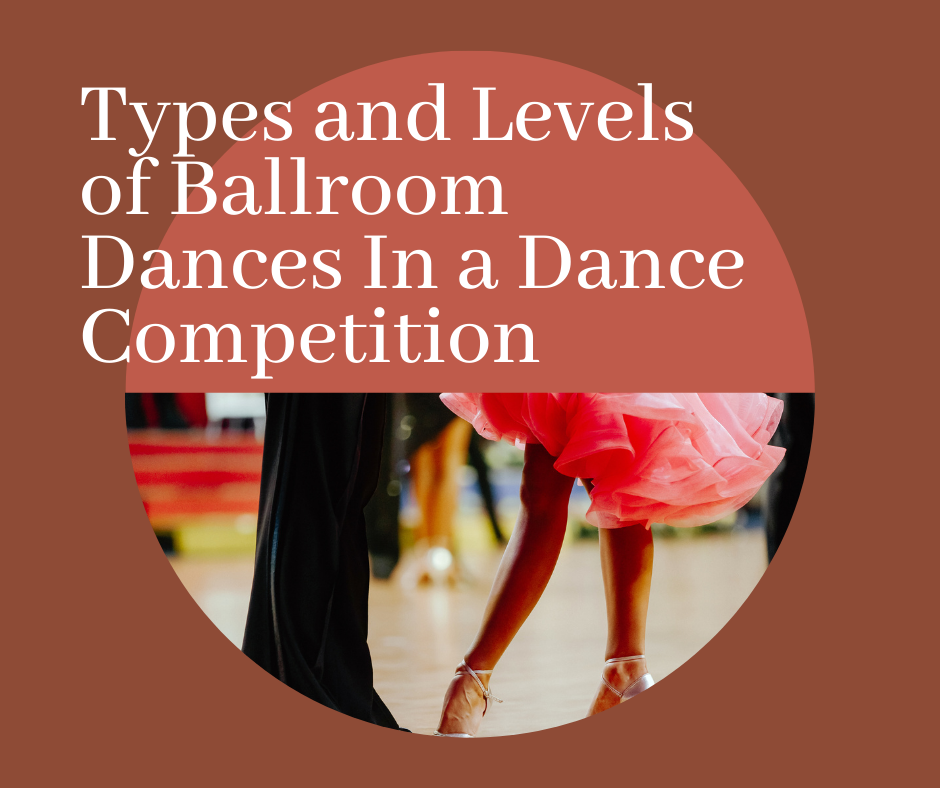
About Ballroom Dance Competitions
by Kathy Fortner with Ralph Hunn
Often, questions are asked about what exactly is a Ballroom Dance Competition some Ballroom Dance Students and their Professional Dance Instructors attend, to compete as a part of their learning and goal setting each year.
There are several reasons this article is being written, with purposes hopefully providing, to the reader,
a) some historical background about ballroom competitive dancing,
b) an explanation of how a dance competition is organized, establishment of guidelines, and set up for the competitors
c) the types and levels of dances competitors choose to dance, and
d) general reasons for an Instructor to compete with his/her student(s) or for Professionals to compete in their chosen dances.

Ballroom dance competitions, also known as DanceSport, have regulations from different organizers for the professionals, amateur (couple without being an instructor), and pro-am (meaning student competes with the instructor). Involved with regulation of competitions is the World Dance Council (WDC), the World DanceSport Federation (WDSF), in Britain, the British Dance Council, and in the US, WDC has that National Dance Council of America (NDCA), and the WDSF (USA Dance), that conduct both regional and national competitions. Various countries have their own regulators and guidelines.
Competitors are judged by criteria “such as poise, the hold or frame, posture, musicality, and expression, timing, body alignment and shape, floor craft, foot and leg action, and presentation.” (4) Judging relies on performance, as in sports, has subjectivity in the decisions of final results sometimes creating some issues. Scoring is based on the Skating System approach, with several couples on the floor at once. Competitors (Amateurs-individuals not dancing with a professional; Pro-Am-student competing with a professional instructor, and Professionals) dance in various levels given their level of ability. Pro-Am couples, the student is judged, not the professional, in Professional dancing, the Professionals are judged as a couple similar to the Amateur competitor.
 Often is heard, Bronze, Silver, Gold, etc. in dancing, such as I dance or compete, in Bronze, each label is type of advancing dance level, then there are levels within each category, such a “Newcomer Bronze” (a student who has had as few as 10 lessons), “Advanced Silver”, “Gold”. Each level, bronze, silver, and gold have certain syllabi (allowed dance steps) for that specific level. A competitor must dance in the level for which they have learned the steps in the syllabus. This is called “closed” category. Then there is the Open type of category- Bronze, Silver, Gold-which does not restrict moves, as with a certain syllabus, can vary their dancing with more complex routines. For example Silver, may have many Bronze steps, yet also have Silver, as a blend of learned steps. Dancing outside, what is known as the designated level during a competition, creates violations and disqualifications for the competitor.
Often is heard, Bronze, Silver, Gold, etc. in dancing, such as I dance or compete, in Bronze, each label is type of advancing dance level, then there are levels within each category, such a “Newcomer Bronze” (a student who has had as few as 10 lessons), “Advanced Silver”, “Gold”. Each level, bronze, silver, and gold have certain syllabi (allowed dance steps) for that specific level. A competitor must dance in the level for which they have learned the steps in the syllabus. This is called “closed” category. Then there is the Open type of category- Bronze, Silver, Gold-which does not restrict moves, as with a certain syllabus, can vary their dancing with more complex routines. For example Silver, may have many Bronze steps, yet also have Silver, as a blend of learned steps. Dancing outside, what is known as the designated level during a competition, creates violations and disqualifications for the competitor.
Music is selected for each type of dance, with specified number of beats per measure (BPM) for the specific level of dance. The music is regulated for the competitor to demonstrate to the judges, usually within 90 seconds, sometimes only 60 seconds, steps learned and executed according to the various performance criteria and syllabus. A very challenging process for the competing couple.
Judges, for competitions, can be at the end of the competition floor, on a stage to see all of the dancers, and sometimes, in more advanced competitions, such as nationals, judges are on the floor in various positions. A Scrutineer (score compiler and reporter) is seated with the judges as it the DJ, as all music is recorded for 90 second or 60 second period of dance.
Each 90 second dance is called a heat. Competitors, in the heat, will generally be competing with other competitors at the same level, for example Bronze, with Bronze at varying levels. The more competitors at a competition, the more “heats”, then Newcomer Bronze will be on the floor with Newcomer Bronze, etc. Smaller competitions may have varying levels of competitors on the floor at the same time.
Competitors are given scores, by the judges, after each heat, which are given to a Scrutineer (score calculator) who tallies all of the scores, then provides final scores to the judges, at the end of the competition for determining how each dance competitor ranked over all in each area of their competing. There are First, Second, Third, etc places, then areas for over all winner, sometimes for Top Female, Top Male, Top Couple, etc.
Heats are set up, during the competition, and numbers of heats can vary depending upon the size of the event, according to the level of the dancers competing, with the Smooth Dances in the First Part of a one day competition, to having Latin/Rhythm in the later part of the day. With a multi-day event, a large national event, this will be held over several days, with rounds and then call backs for those who move up through the event with competency.
Heats, may have only individual dances, in Smooth, for example only Waltz, Viennese Waltz, or Cha-Cha, then proceed to multi-dances events, with dances (Smooth or Rhythm/Latin) meaning 3, 4, or 5 90 second dances at one time, at a particular level. In the American Multi-Dance Challenge, you will have Waltz, Foxtrot, and Tango or Waltz, Tango, Foxtrot, and Viennese Waltz. The International Smooth will vary. The same approach applies to the Latin/Rhythm part of the event, with a Multi-Dance Challenge with three dances, would be Cha-Cha, Rumba, and East Coast Swing.
Other dances are added to competitions, such as Salsa, West Coast Swing, Hustle, Merengue, Bachata, Argentine Tango, and some Country type dances, such as Country East Coast Swing, Country Cha Cha or Country Waltz.
Heats are pre-arranged, prior to the competition, with a list created for use, determining when the competitors coming to the floor, for their timed and scheduled heat, they wait, enter the floor when called, the Leader determines the position for the Follower, the space on the floor, the music begins for the particular dance, for 90 seconds, then ends suddenly, the dancing stops, then couple leaves the floor. For Multi-dance events, the couple will remain on the floor for the number of dances in the Multi-Dance challenge, 3, 4, 5, etc. then after all dances are finished, unless there is another heat, they leave the floor. The Multi-Dance events are very demanding, can be tiring, if scheduled back to back.
What is important for the reader to be aware of is the competitor, Pro/Am, Amateur, Professional, begins an early day preparing for the Smooth Dance Event, sometimes at 6:00 am getting ready (for women generally), then going to “warm up” prior to start of the event, around 8 am, some events may start earlier, then may compete until between 5-6 in the evening, sometimes later. During these times, dress changes between Smooth to Latin/Rhythm, with quick meals, and then warm up prior to the start of the competition in the afternoon. The leaving again going to change, for the dress event, to have dinner, then see if they were in the Winner’s Circle during the evening. A very, very long day for all involved.

In competitive ballroom dancing, there are two styles or divisions, American and International.
American Style dances are divided into two types, Smooth and Rhythm. In the Smooth, there is separation between the Leader and Follower, which varies according to the level of dancing-Bronze. Silver, and Gold, in being able to open up in several steps and less strict. The Smooth dances are Waltz, Foxtrot, Tango, and Viennese Waltz. In Rhythm, mistakenly called sometimes, American Latin, the dances are Cha-Cha, Rumba, Swing (East Coast), Mambo, and Bolero. In American Rhythm, “Cuban motion (hip action) is achieved by flexing the knee after taking a step”. (13)
International Style for Smooth Dances is known at Standard, where the leader and follower are always in closed position, compared to the American style. International Standard dances are Waltz, Foxtrot, Tango, Viennese waltz, and Quickstep. International Latin is known for rhythm dances, with the hip action is stepping on a straight leg, different than the American style. International Latin dances are Cha-Cha, Rumba, Samba, Paso Doble, and Jive. (13)
Dances and competitors are typically categorized in various ways so as to create different competitive divisions. These categories are not standardized, and may vary significantly from one competition to another such as varying age levels, types of distinctions between levels, and types of dances to be danced, closed, open, multi-dance that can be three, four, five, etc. Also there are performance type dances included in some competition events.
During dance competitions, and depending upon levels, some competitors compete in both Smooth and Latin/Rhythm, knowing between 11-14 dances, sometimes in two levels, say Bronze, then Beginning Silver. They hope for competency in both areas and keep in the two levels to maintain competency until winning out of the lower level.

Reasons to choose to compete vary among various dancers, yet generally these are what generally are noted by both students and their professional dance instructors:
- Improves the student as a dancer
- Having goals established to learn at a more intense level
- Working toward meeting the established goals
- Learning the various dances for competitions, the mechanics, types of music, partner roles, and stretching oneself to achieve
- Having feedback at competitions by National, and sometimes international judges to provide guidance on developed strengths, and to become aware of weaknesses that need to be strengthened
- Being involved in a community of fellow competitors with travel to various competitions, involved in the excitement and fun, and work during competition competing, yet having a great deal of learning in many areas. (5)
Other reasons, some Stanford University resource, cites dancing for different audiences. For ballroom dance competitions, for the
“Judges” —“they want see that the steps and styles are done precisely and correctly, with great flair”;
“Student focus”, “It’s how…dancing looks, for the judges. The appearance”
“The attitude” “rigorously correct, expansive”, the “many styles outside of the official syllabus are usually considered incorrect”,
“Attitude about making mistakes” “judges deduct points for every mistake, so competitive dance culture is aligned against making mistakes from day one, when a follow does something different from what the Lead intended, he considers it a mistake, which is to be eliminated, competitive dancers work hard to achieve 100{e9420259e37f7dd44db68ca7ce0dae768f0647300582c8437fea6ed4ec6f4cdd}; “
“The Reward” Competing. Impressing others. Winning. The satisfaction of becoming proficient in a dance form. Self Confidence
“Standardized steps and technique” Yes, rigorously standardized because competitors need to know exactly what technical details the judges expect to see.
“Standardized style” Yes, you are trained to copy the style of the champions before you, working hard to imitate the shape of that standardized style. Individuality can be admired, but only within strict parameters.
“Fixed Choreography” Yes (to a degree-syllabus). Competitors usually perform choreographed routines that they have rehearsed. (I will make a note in variance from the article, in my experience and training by my instructor, learning, knowing, and being taught steps of a dance, being able to follow, when, needed, say in smooth, traffic, such as in the Waltz, Viennese Waltz, etc. then then should the leader need to change, choreography may fall apart; the follower only knowing a routine, may not be able to adjust or react quickly, the art of following; my teacher’s approach, learn to follow).
“Making Own Decisions” Usually not. Most decisions have been made by others, first in the syllabus of acceptable steps, then in the choreographed routine. You work mostly on style. (Variation from the article is, that yes there are decisions of what steps to use given the type of competition and use of sometimes combined and blended steps of various syllabi for a certain level can be used)
Further, as cited in the Stanford article, “competitive ballroom technique is intentionally difficult, so that only the very best dancers can master it”. “It requires many years, and extreme focus, to master this technique”. A quote from a US Ballroom Dance Champion Stephen Hanna, “You must want to go to the very top and be the very best dancer. You must be able to use your time seven days a week without allowing any other influences to interfere”. (7) Further it is cited, “This is not a problem. Competition ballroom dance is also known as dance sport, and competitors in every sport train hard to win. It’s work, and competitions are usually stressful”.
A quote from the Stanford article stated, from Fred Astaire, “Cultivate flexibility. Be able to adapt to your style to that of your partner. In doing so, you are not surrendering your individuality, but blending it with that of your partner”. To me, this is what has cultivated over the years doing competitive dancing, respect for the art, and respect for the instructor who teacher, my dance partner, flexibility with making decisions about how to approach the dances, competitions, the building for the event, and kindness even when things are so tough with frustration on my part, with myself, and knowing my instructor has been frustrated yet it is approached with flexibility, knowing how to readjust, correct for learning, with his years of teaching to be successful.
For me, personally, and having been taught by Ralph, over these several years, I have learned to have fun mixed into the practice and learning-the hard work to learn many dances, unlike Performances, with focus on only one dance, sometimes one level. And also, it has made me a better social dancer, and performer, as I understand the dances, the music, and how it all fits together. This focused process has worked well for both of us, instructor/student, Pro/Am competitor, and performers. As Ralph, says, and any instructor will say, “learning ballroom dancing, even at the competitor level, never ends, as there are on going changes, something new learned, something missed reviewed, learning is on going.” Both my instructor, and others who teach Ballroom Dancing, in order to compete are so correct in this view. This is why ballroom dance competition preparation and competing is so important to me. And, these are truly the reasons I enjoy it so much, as it has made me a much better dancer.

(1) https://socialdance.stanford.edu/syllabi/English_ballroom_style.htm
(2) http://socialdance.stanford.edu/syllabi/Standardized_tempos.htm
(3) https://deepblue.lib.umich.edu/bitstream/handle/2027.42/63821/aabra_1.pdf
(4) https://en.wikipedia.org/wiki/Ballroom_dance
(5) https://nationaldanceclubs.com/the-immersion-factor-benefits-of-ballroom-competitions/
(6) http://www.udancefest.com/guide/
(7) https://socialdance.stanford.edu/syllabi/ballroom.html
(8) https://socialdance.stanford.edu/syllabi/astaire.htm
(9) https://socialdance.stanford.edu/syllabi/connection.htm
(10) https://www.nwdance.net/publications/before-you-sign-up-different-types-of-partner-dancing/
(11) https://en.wikipedia.org/wiki/Competitive_dance
(12) https://www.liveabout.com/what-is-competitive-dancing-1007277
(13) https://cdn.ymaws.com/usadance.org/resource/resmgr/collegiate/ballroom101college-rev10-09-.pdf
(c) Copyright Affordable Dancing Latin and Ballroom, Kathy L. Fortner, Student of Ralph Hunn, and critiqued, reviewed and approved by Professional Dance Instructor, Ralph Hunn, Owner, Affordable Dancing.
Permission given to Ballroom Dance Preservation Society for publication to the non-profit website, 9/2020.
Permission necessary for additional publication rights must be approved by Affordable Dancing Latin and Ballroom and/or Ralph Hunn.
